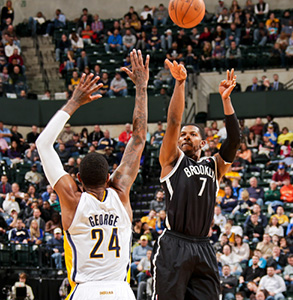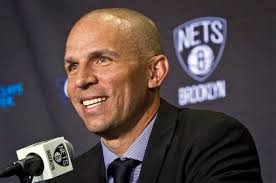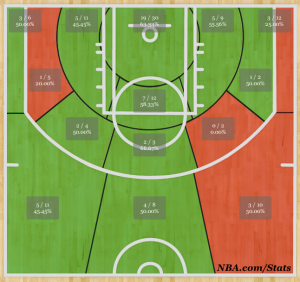 The Brooklyn Nets wanted to improve on both sides of the ball after ending 2013 with a disappointing 10-21 record.
The Brooklyn Nets wanted to improve on both sides of the ball after ending 2013 with a disappointing 10-21 record.
Unlike most people’s new year’s resolutions, they’ve stuck to it.
With All-Star center Brook Lopez out for the season, head coach Jason Kidd thought going with a smaller starting lineup would benefit the team going forward and afford the team versatility in many respects.
It worked. Big time.
The Nets are 7-1 in the month of January and rising in the Eastern Conference standings after a 103-80 drubbing of the Knicks on Monday at Madison Square Garden, avenging a lopsided loss to New York from earlier in the season and holding the Knicks to 31 percent shooting, which would make even the most inept offensive team cringe with embarrassment. In the month of January, Brooklyn is outscoring opponents by seven points per 100 possessions.
“The new year has been good to us,” Nets guard Joe Johnson said after his 25-point performance. Johnson has played especially well in 2014, averaging 19.8 points per game on 48 percent shooting, excellent for a shooting guard who’s taken 15.6 shots per game this month. Here’s what Johnson’s shot chart looks like for the month. Notice all the green…
The smaller lineups have Kevin Garnett starting at center for Lopez, Paul Pierce at power forward, Johnson at the 3 and Shaun Livingston and Alan Anderson playing more important roles. It’s paid dividends offensively.
| Nets (League Rank) | Points | FG % | 3 FG % | FGA | O Rating | Pace | 2nd chance |
| January | 98.9 | 46.2 (12) | 36.8 (11) | 78.1 (27) | 107 (8) | 90.1 (30) | 13.1 |
| December | 98.1 | 44.7 (17) | 37.1 (8) | 78.5 (29) | 102.6 (17) | 93.73 (27) | 7.3 |
The second chance points are way up, and the field goal percentage is noticeably better. The Nets are still one of the slowest teams in the league, but they’ve become more efficient in moving the ball around and hitting mid-range jumpshots, which you’ll see in the following statbox.
| Nets shot % (League Rank) | <5 Feet | 5-9 Feet | 10-14 Ft | 15-19 Ft | 20-24 Ft |
| January | 55.4 (25) | 42.6 (8) | 48.5 (3) | 50 (1) | 37.3 (16) |
| December | 56.8 (20) | 41.4 (5) | 40.2 (13) | 40.7 (13) | 39.4 (5) |
You can see an incredible improvement in the team’s percentages from between 10 and 19 feet. Garnett is now being more selective, hitting exactly two-thirds of his shots this month while taking just 5.5 of them per game. Andray Blatche is shooting 52.1 percent this month.
“They’re believing that they could play both sides of the ball and they’ve been doing that at a high level of late,” Nets head coach Jason Kidd said. “The ball movement has been contagious.”
Need proof that the small lineups are working? Brooklyn’s primary January starters; Livingston, Anderson, Johnson, Pierce and Garnett, are outscoring opponents by an amazing 29.1 points per 100 possessions with a beyond ridiculous 80.5 defensive rating.
That defensive improvement in 2014 has seen the Nets allowing 6.7 fewer points per 100 possessions in January than in the team’s 5-9 December.
 A lot of that has to do with the team’s newfound versatility, with Livingston as the unlikely linchpin.
A lot of that has to do with the team’s newfound versatility, with Livingston as the unlikely linchpin.
“It makes us a lot more versatile because we could switch one through four,” Nets wing Alan Anderson said. “Shaun is a 6’7, 6’8 point guard. When they set screens on him, he could guard a four. So it makes things a lot more easy.”
A few weeks ago, Hawks guard Kyle Korver was talking about how well Livingston closed out on his shots using his unusual size and length, and it nearly caused the end of his record 3-pointer streak last week in London. Livingston has emerged as an impactful player in Deron Williams’ absence and now Livingston said he’s gotten to know players’ tendencies, which puts him in an advantageous situation both physically and mentally.
“We’ve got a point guard with a wingspan of over seven feet,” Anderson said. “Usually when the ball-screen comes with the one and the four, you can’t switch it. But with him, you could switch it because he could guard the one through the four. Me, AK [Andrei Kirilenko], Paul, Joe, Shaun, we could switch one through the four and hold our ground.”
Anderson has been solid defensively, and the Nets are outscoring opponents by 8.8 points per 100 possessions with Anderson on the floor. Kirilenko has been huge for the Nets’ defensive versatility as well. He has the agility to still guard athletic wings, but the size and strength to contend with power forwards as well. Brooklyn is 7-2 since Kirilenko’s return to the lineup, which is no coincidence. And Livingston thinks that the team’s rhythm starts on D.
“Since we’re getting into a rhythm and setting the tone defensively, we’re getting into a rhythm offensively,” Livingston told Sheridan Hoops. “Roles are kind of just being cemented. If you’re open, you take the shot. If you’re not, swing to the next person.”
Livingston then sent out a warning of sorts to the rest of the league: don’t try to match up with Brooklyn’s small lineup.
“If they’re gonna play small and match up with us, the thing is when we play small we still have some size and we still have some depth,” Livingston said. “We still have shooters. When they play small, we just have to take advantage of our mismatches.”
 With Williams now back in the fold, those mismatches with the small lineups could become even more apparent to the Nets’ opponents.
With Williams now back in the fold, those mismatches with the small lineups could become even more apparent to the Nets’ opponents.
“Once we’re getting stops and we’re a different team by defending and getting easy baskets, it’s fun,” Anderson said.
With the Brooklyn Nets winning games and having more fun in 2014, it seems like some resolutions could be kept after all.
Shlomo Sprung is a national columnist for Sheridan Hoops who loves advanced statistics and the way they explain what happens on the court. He is also the web editor of the Brooklyn Daily Eagle. A 2011 graduate of Columbia University’s Journalism School, he has previously worked for the New York Knicks, The Sporting News, Business Insider and other publications. His website is SprungOnSports.com. You should follow him on Twitter.

I don’t agree that Small ball is the main reason Nets are winning. The main reason is that Kirilenko has returned and is now getting more minutes. And his defense is contagious.
Also, without Brook, Nets aren’t standing around as much as before
And although Blatche can play PF, with the present team he is much better off playing Center and dominating the paint. Blatche isn’t part of the Small Ball, but when not in foul trouble he should play 30-32 minutes per game at Center. The “Good” Blatche is one of the Nets best players, along with JJohnson, DWill and Kirilenko. You always want to use your best players as much as possible. Not having Lopez has helped KG. There are lots of reasons beyond “small ball” why Nets are playing better. They are likely to get even better (if no injuries) as DWill contributes more and Blatche and AK increase their minutes. Getting Marquis Teague should allow Livingston to play more with DWill.
One reason why Joe Johnson doesn’t play more SF is that it may result in more wear and tear, which is a concern after a bout with plantar fasciitis last season (cost Nets the first round of playoffs).